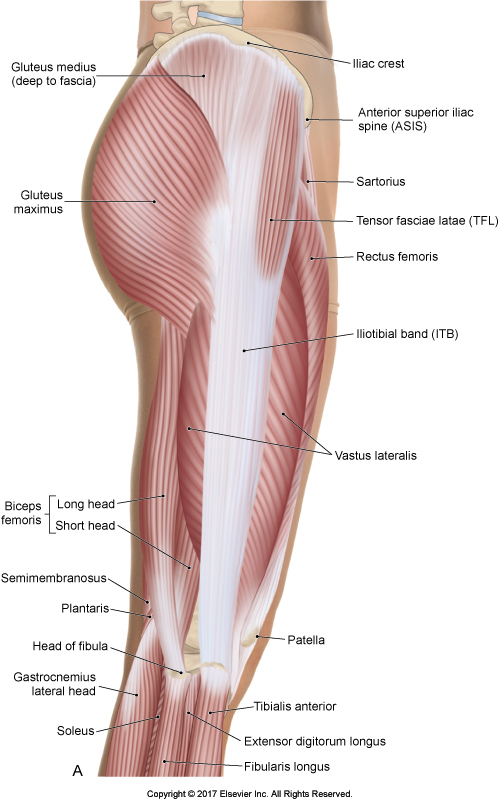There seems to be a belief, propagated mainly through social media, that the iliotibial band (ITB) cannot be stretched and thus manual treatment on the ITB is futile. There is a lengthy discussion on this topic in Terra Rosa e-magazine #18. Now a new study published in the Feb 2017 issue of International Journal Sports of Physical Therapy revisits this topic again.

Lateral view of the right Iliotibial Band (ITB). Permission Joseph E. Muscolino. The Muscular System Manual – The Skeletal Muscles of the Human Body, 4ed. (Elsevier 2017)
A group of physical therapists and researchers from Texas, Austria, and Germany conducted a study on cadavers to describe the iliotibial band tensor fasciae latae (TFL) complex (ITBFLC) tissue elongation as a response to a simulated clinical stretch in-vitro.
Six right-sided ITBTFLCs were harvested from six un-embalmed human cadavers (3 male and 3 female) with a mean age of 81.5 (ranging from 73 to 92 years). The authors simulated a clinical stretch of 2.75% elongation and recorded the strain responses of the ITBTFLCs. Four sets of array marks were placed along the length of the ITBTFLC. Photographic images were taken in resting position (with 1% elongation) and with an additional 2.75% elongation. Tissue elongation was compared between proximal, middle, and distal ITBTFLC regions.
The results and statistical analysis showed a significantly longer ITBTFLC in the “stretched” versus resting condition. Significant elongation was observed in the proximal (3.96mm), middle (2.12mm) and distal (2.25mm) regions during the “stretched” versus the resting condition.
Digital COMT
Did you know that Digital COMT (Digital Clinical Orthopedic Manual Therapy), Dr. Joe Muscolino’s continuing education video streaming subscription service for massage therapists (and all manual therapists) and movement professionals, has six folders with video lessons on Manual Therapy Treatment, including an entire folder on Stretching, as well as a folder on Pathomechanics, another on Anatomy, and many more? Digital COMT adds seven new video lessons each and every week. And nothing ever goes away! Click here for more information.
The authors concluded that the ITBTFLC is capable of elongation in response to a clinically simulated stretch. The proximal ITB region underwent significantly greater elongation than the middle and distal regions and may be more likely to respond to “stretching” in clinical situations. They further stated that the results do not challenge the perceived clinical benefit of ITB stretching, but suggest that benefits may be related to changes at the level of the TFL as opposed to the ITB proper. After all, the ITB functions as a long tendinous extension of the TFL, doesn’t it?
This study on cadavers with a mean age of 81 years should also not to be interpreted to mean that we should not work on the ITB because of the minimal stretch achieved in this study. As discussed in Terra Rosa e-magazine #18, Art Riggs, a manual therapist and instructor, warned us: “Don’t let studies on cadaver deter you from working on the ITB.” Further, the advanced age of most the bodies in most cadaveric studies, including this one, should also be taken into account.
Dr. Robert Schleip also commented:
“Stimulating mechanosensory nerve endings in the ITB could very well trigger resulting downstream effects in the tonus of related muscle portions (gluteus maximus, TFL, vastus lateralis) as well as in the blood/lymph supply to this band. In addition, the inherent fibroblasts in this tissue may react via changes in their metabolism and cytokine expression during subsequent hours. Current concepts on manual therapy include neuromyofascial reflexes and autonomic responses, etc. Of course you will miss these potential responses in a cadaver study.”
This blog post article in reprinted with the kind permission from Terra Rosa.
(Click here for an article on how to assess ITB Friction Syndrome with Noble’s Compression test.)


